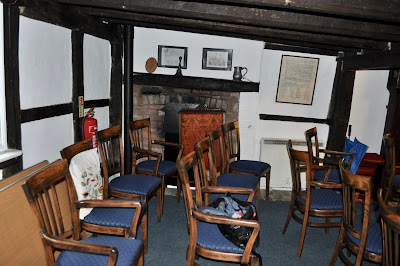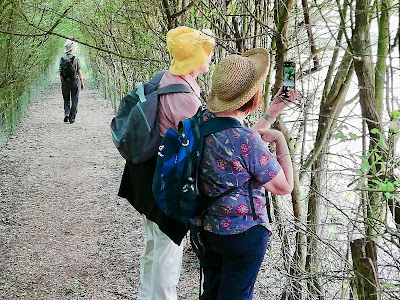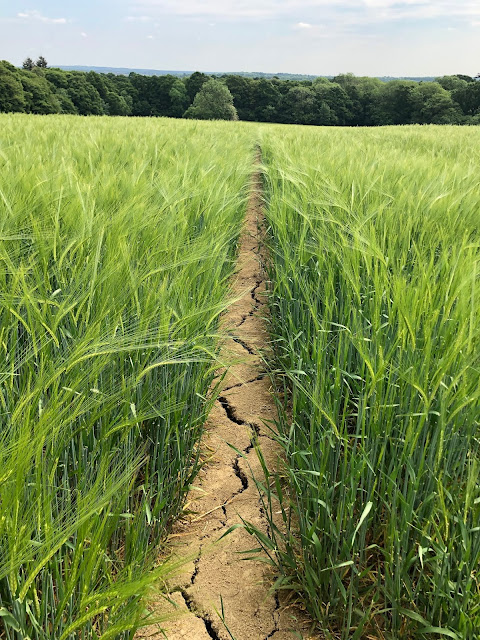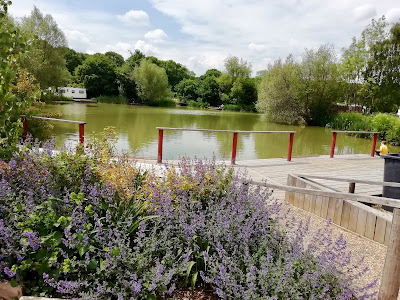When Horsham NWR group became aware that 2019 was to be officially designated as Horsham District Year of Culture, we were keen to become involved in some way. At a planning meeting, it was decided that we would celebrate the literary connections with our county by walking the 55 mile route of the West Sussex Literary Trail (WSLT) devised by Peter Anderson and Keith McKenna, from Horsham to Chichester, in short sections over the late Spring and early summer.
One member of our group, Liz, is an experienced HF Holidays walk leader and a regular leader of Horsham District Council's Walks for Health, so her enthusiastic response and wide-ranging knowledge of the West Sussex countryside has proved invaluable.NWR walks the West Sussex Literary Trail 2019
Monday, June 14, 2021
Horsham to Slinfold
In 1823 William Cobbett, political journalist who furthered the freedom of the press, parliamentary reform and who launched the reporting of proceedings in Parliament (later to become Hansard), visited Horsham and described it as:
"a very nice, solid, country town. Very clean, as all towns in Sussex are ....Sussex women are very nice in their dress and in their houses".
What would he say if he could see us now in our bright cagoules and clumpy walking boots, I wonder?
The trail begins in Horsham at the junction of West Street and Bishopric where 'Rising Universe' a large kinetic sculpture better known as the 'Shelley Fountain', stood until 2016. It commemorated one of the most well-known English Romantic poets, Percy Bysshe Shelley. A radical thinker, with strong political and social views, Shelley did not live to see success but was posthumously much admired by other great luminaries such as Robert Browning, Thomas Hardy, George Bernard Shaw, Oscar Wilde and Karl Marx amongst others.
Two years ago the fountain was in such a state of disrepair that the council decided it was time to dismantle it and replace the fountain with modern seating set around a ring of silver birch trees.
This is the start of our walk along the Weald and Downs.
 |
| Horsham's ring of silver birch trees |
Adjacent to the trees is West Street where a simple stone plaque commemorating Shelley can now be found.
 |
| Stone Plaque, West Street, Horsham |
We shall return later to the great poet's connection to the area, but before then, mention of one or two other literary links to our town.
Arthur Beckett (1871-1943) was born in Yorkshire but came to Sussex as a child and grew to love the county. He described Horsham as "a place meet for high adventure" and he became the first President of the South Downs Society, a journalist and the founder and editor of the Sussex County Magazine which remained in publication until 1956.
Georgette Heyer, prolific writer of historical romance and detective fiction (some with Sussex settings) opened a sports shop in Bishopric in 1928 with money borrowed from her aunts. The shop was run by her husband and brother whilst Heyer devoted herself to becoming the main breadwinner, turning out novels annually throughout most of her 50 year career.
Arthur Beckett (1871-1943) was born in Yorkshire but came to Sussex as a child and grew to love the county. He described Horsham as "a place meet for high adventure" and he became the first President of the South Downs Society, a journalist and the founder and editor of the Sussex County Magazine which remained in publication until 1956.
Georgette Heyer, prolific writer of historical romance and detective fiction (some with Sussex settings) opened a sports shop in Bishopric in 1928 with money borrowed from her aunts. The shop was run by her husband and brother whilst Heyer devoted herself to becoming the main breadwinner, turning out novels annually throughout most of her 50 year career.
 |
| Georgette Heyer |
Leaving Horsham town centre, the trail takes us through the local park, past the Human Nature garden, illustrating links between plants and people,
 |
| Human Nature Garden |
Before long we pass under the busy A24 towards Warnham Deer Park. The estate is owned by the Lucas family who made their fortune in 19thC engineering projects such as the Aswan Dam, the Royal Albert Hall, Covent Garden Opera House and Charterhouse School.
As a group we walk quietly through the deer paddocks at Bailing Hill Farm, knowing all too well that these stud deer are of world renown and their genes are 'disseminated' worldwide.
Shelley was born in nearby Field Place (now privately owned) and the area round here was his childhood stomping ground. Just a short distance along the road from the farm (but not on our route) is the church where Shelley was baptised on 7 September 1792 and the certificate is displayed there. Shelley reputedly often played around Warnham Mill Pond and with his sisters, exploring the surrounding woods and fields as far away as Strood House, now known as Farlington School.
We reach the brow of a hill giving us views of Horsham and the South Downs then continuing our walk, we skirt the beautiful 33 acres of Farlington School.
As a group we walk quietly through the deer paddocks at Bailing Hill Farm, knowing all too well that these stud deer are of world renown and their genes are 'disseminated' worldwide.
 |
| Warnham Park deer |
 |
| Bailing Hill Farm dating back to 1375 but unsympathetically 'modernised' |
Shelley was born in nearby Field Place (now privately owned) and the area round here was his childhood stomping ground. Just a short distance along the road from the farm (but not on our route) is the church where Shelley was baptised on 7 September 1792 and the certificate is displayed there. Shelley reputedly often played around Warnham Mill Pond and with his sisters, exploring the surrounding woods and fields as far away as Strood House, now known as Farlington School.
We reach the brow of a hill giving us views of Horsham and the South Downs then continuing our walk, we skirt the beautiful 33 acres of Farlington School.
 |
| Farlington School |
Rowfold Farm covers 170 acres and the owners have introduced many conservation measures to increase wildlife including growing RSPB recommended crops next to hedges that provide suitable habitats for birds, and the building of an otter holt by the riverbank. Unfortunately, no otters were to be seen on the day of our walk!
Soon we are walking downhill to the parish church of St Peter in the old fashioned village of Slinfold.
 |
| St Peter's Church and lychgate |
 |
| A lovely church brass to the right of the altar dated 1533 |
In 1932 Georgette Heyer rented a house in Slinfold and it was here that she wrote one of her most famous books, Regency Buck. I wonder if there's a copy in the village's telephone box library?
 |
| Slinfold Library |
We pause on the path between the gravestones where a trestle table is set up, to buy a few tomato plants and seedlings but unfortunately we are too late for a cuppa and we're forced to retreat to the Red Lyon to quench our thirsts!
 |
| Disappearing into the Red Lyon in Slinfold |
Finally, to end the first section of our walk, a fairy story:
It is said that there is a boggy hollow near Slinfold which contains a sunken bell from the church. Long ago some villagers, hoping to retrieve the bell, sought advice of a witch. She told them that it could only be retrieved, in silence, by use of 12 white oxen, at midnight. The oxen were used, but one villager broke the witch's instructions by shouting 'hurray', and the bell sank back into the bog.
Slinfold to the Blue Idol
Today, with sun hats, sun glasses and sun screen we set off on the second leg of the West Sussex Literary Trail, starting from the pretty village of Slinfold with its former bakery and post office now 're-purposed' to provide private homes.
Incidentally, the pub has changed its name several times over the years. First referenced in 1513, the building was known as Nibletts Farmhouse, before becoming some sort of alehouse run by a landlord, John Penfold, who appears in court records of the 1630s being fined for selling illegal measures! It became The Red Lyon, then The King's Head then reverted to The Red Lyon again!
through the kissing gate
to emerge shortly afterwards in the graveyard of St Nicholas Church, Itchingfield.
Records show that the strange custom of 'skug hunting' (chasing squirrels) on Boxing Day was practised in the woods around Itchingfield well into the 19th century.
We quickly find the grave of David R Francis, a local historian, who wrote many articles for the parish magazine about Itchingfield and the main settlement of Barns Green. Here he is is seen on the right.
Although there has reputedly been a church on this site since 1125 AD, the church was only dedicated to St Nicholas in 1513 and the wooden bell tower, built entirely of oak, is believed to be the only example of its kind in the country. Apparently, because the tower is not attached to the church, when the five bells are rung the tower rocks from side to side!
The 16th C Priest House used to be the cottage where the paid clerical assistant to the priest lived, but its use was extended by 1580 to house the local poor.
Leaving the churchyard, we soon come across the rather sad sight of the old Itchingfield School where one of our walkers once taught. It closed in 2015 after serving the local population for 161 years, but before closure the school children buried a time capsule in the grounds.
Next, we stray only a couple of metres or so from our trail, to visit Julia and Emma's Arboretum and Memorial Garden. This beautiful and poignant site is devoted to the memory of a mother and her young daughter who were tragically killed in South Africa in 1996.
Back on the trail we pass through the gates of Muntham Lodge
and soon encounter Muntham House School.
Down the track we go, through the woods all the while knowing we are now only a stone's throw away from our lunchtime destination in Barns Green.
Time now for our lunch stop at the beautiful Sumners Ponds.
Nearby, at Newbuildings Place, Shipley, lived Wilfred Scawen Blunt (1840-22), author, poet, traveller and breeder of Arab horses. Amongst others, Hilaire Belloc, Oscar Wilde, William Morris, Ezra Pound, John Masefield and Winston Churchill all visited the house. Blunt died here and is buried in the grounds behind the house.
Another well-known resident of Shipley was the poet and writer, Hilaire Belloc (1870-1953). In 1906, he purchased land and a house called King's Land at Shipley where he brought up his family and lived until shortly before his death. More of him further along the trail.
After refuelling, we set off once more heading for the section of the walk that is the 'Low Weald', an area of ponds, streams and copses which in days gone by provided charcoal for local iron and glass industries. We reach the railway crossing just as a train goes whizzing by, thankful that we can enjoy the countryside at a much more leisurely pace!
The air is filled with the sound of birdsong. We encounter a group of llamas
an old weighing machine
and verges dotted with wildflowers and self seeded aquilegia.
Suddenly we emerge onto the busy A272 to Billingshurst and are forced to do a section of road walking before turning off into Old House Lane. In 400 metres we reach today's destination, The Blue Idol.
The oldest part of this building dates from the late 16th century. In 1690 it became the Quaker Meeting House where William Penn (1644-1718), writer, debtor and founder of Pennsylvania, attended regularly, although Warmington 4 miles away, was his home in England for over thirty years.
We are warmly welcomed to this most peaceful site by some Quaker Friends, who kindly offer us cups of tea, for which we are most grateful.
Join us again when we walk next time from The Blue Idol to Cootham!
 |
| Did anybody do a spell check on the pub name? |
Turning down Hayes Lane we quickly pass a small pond and very soon cross over the 'Downs Link' another popular walking route, 37 miles long, linking the North Downs with the South Downs.
 |
| Right to Guildford, left to Bramber |
A short distance from this point along the Downs Link is Christ's Hospital, Bluecoat School which was founded in 1552 by King Edward VI, but which moved to West Sussex in 1902. Its pupils wear a distinctive school uniform said to be the oldest still in existence and 95% of modern pupils voted to continue wearing it.
Past pupils known principally for their literary prowess were Samuel Taylor Coleridge (poet and literary critic), Charles Lamb (essayist), Leigh Hunt (critic, essayist and poet) and Bernard Levin (journalist, author and broadcaster). However, two lesser known 'Old Blues' are worthy of a mention on this 'literary trail'. Firstly, Edmund Blunden (1896 - 1974) was at the school when WW1 began. He enlisted into the Royal Sussex Regiment, fought at Ypres and the Somme where he was awarded the Military Cross, and miraculously lived to tell the tale. Afterwards he became a Fellow and tutor of English at Merton College, Oxford, writing 'war poetry', and biographies of Percy Bysshe Shelley, and the aforementioned past pupils, Charles Lamb and Leigh Hunt. He was nominated for the Nobel Prize for Literature six times and is commemorated in Poets' Corner in Westminster Abbey.
Secondly, Keith Douglas (1920-1944) began writing poetry whilst still at Christ's Hospital School. In 1938 he entered Blunden's old alma mater to study English but when WW2 broke out he enlisted and served as a tank commander in N Africa. He was wounded in the D Day landings 1944 and died three days later, cutting short the full promise of a career as a poet.
Secondly, Keith Douglas (1920-1944) began writing poetry whilst still at Christ's Hospital School. In 1938 he entered Blunden's old alma mater to study English but when WW2 broke out he enlisted and served as a tank commander in N Africa. He was wounded in the D Day landings 1944 and died three days later, cutting short the full promise of a career as a poet.
If we were to walk just a very little way further along the Downs link we would soon reach the village of Southwater where Lintot Square is named after the publisher, Bernard Barnaby Lintot
(1675-1735). He became a bookseller in London then progressed into publishing, authors such as Alexander Pope, John Dryden and John Gay being amongst his customers, and it was Lintot who used illustrations related to text (rather than for decoration alone), for the first time.
Turning off the Downs Link we head through fields where we spy spotted orchids and speckled wood butterflies in abundance, then uphill into woodland, glad of a few minutes' shade.
Soon we are back into open fields bordered by a dog rose hedge
before the footpath leads us through thigh-high fields of waving barley.
Soon we are back into open fields bordered by a dog rose hedge
before the footpath leads us through thigh-high fields of waving barley.
through the kissing gate
to emerge shortly afterwards in the graveyard of St Nicholas Church, Itchingfield.
Records show that the strange custom of 'skug hunting' (chasing squirrels) on Boxing Day was practised in the woods around Itchingfield well into the 19th century.
We quickly find the grave of David R Francis, a local historian, who wrote many articles for the parish magazine about Itchingfield and the main settlement of Barns Green. Here he is is seen on the right.
Although there has reputedly been a church on this site since 1125 AD, the church was only dedicated to St Nicholas in 1513 and the wooden bell tower, built entirely of oak, is believed to be the only example of its kind in the country. Apparently, because the tower is not attached to the church, when the five bells are rung the tower rocks from side to side!
 |
| The 14th C timber belfry tower built without nails, was renovated in the 1860s |
 |
| Church of St Nicholas, Itchingfield |
The 16th C Priest House used to be the cottage where the paid clerical assistant to the priest lived, but its use was extended by 1580 to house the local poor.
 |
| The Priest House |
Leaving the churchyard, we soon come across the rather sad sight of the old Itchingfield School where one of our walkers once taught. It closed in 2015 after serving the local population for 161 years, but before closure the school children buried a time capsule in the grounds.
 |
| Ripe for development? |
 |
| Beautiful blue iris |
Back on the trail we pass through the gates of Muntham Lodge
and soon encounter Muntham House School.
 |
| Muntham House School |
Time now for our lunch stop at the beautiful Sumners Ponds.
Another well-known resident of Shipley was the poet and writer, Hilaire Belloc (1870-1953). In 1906, he purchased land and a house called King's Land at Shipley where he brought up his family and lived until shortly before his death. More of him further along the trail.
After refuelling, we set off once more heading for the section of the walk that is the 'Low Weald', an area of ponds, streams and copses which in days gone by provided charcoal for local iron and glass industries. We reach the railway crossing just as a train goes whizzing by, thankful that we can enjoy the countryside at a much more leisurely pace!
an old weighing machine
and verges dotted with wildflowers and self seeded aquilegia.
Suddenly we emerge onto the busy A272 to Billingshurst and are forced to do a section of road walking before turning off into Old House Lane. In 400 metres we reach today's destination, The Blue Idol.
The oldest part of this building dates from the late 16th century. In 1690 it became the Quaker Meeting House where William Penn (1644-1718), writer, debtor and founder of Pennsylvania, attended regularly, although Warmington 4 miles away, was his home in England for over thirty years.
 |
| The Quaker man was at one time identified as William Penn |
 |
| Interior of the Meeting House |
 |
| Relaxing with a cuppa at the end of our walk |
We are warmly welcomed to this most peaceful site by some Quaker Friends, who kindly offer us cups of tea, for which we are most grateful.
Join us again when we walk next time from The Blue Idol to Cootham!
Subscribe to:
Comments (Atom)


































